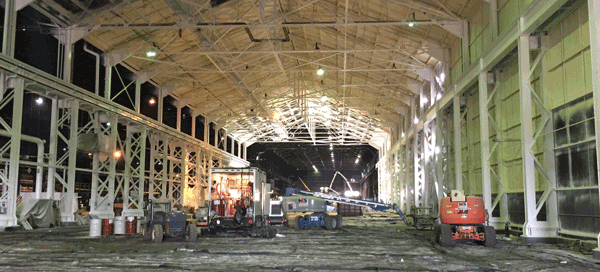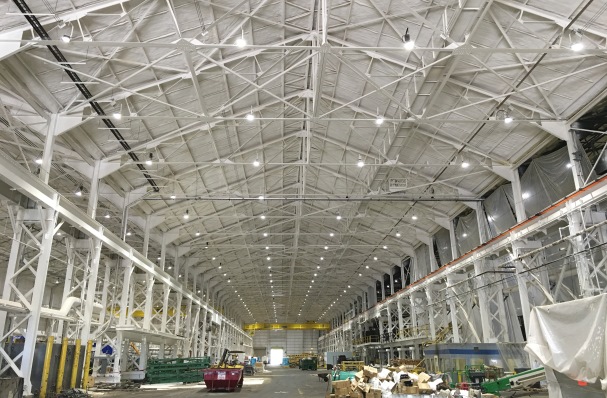Lucky for the crew from West Roofing Systems, Inc., the methods of Michelangelo painting the Sistine Chapel are gone. No longer do painters — or in this case spray polyurethane foam (SPF) and intumescent coating crews — have to work nearly upside down on scaffolds. Now, they’re able to use lifts that are not only easier to move but offer a safe option — something that the crew from West Roofing Systems relied on during a recent steel facility rehab.
Spidey Sense
At 75 feet tall (22.9 m) at the highest peak, working on this project was a vertical challenge. According to West Roofing Systems’ President and CEO Jack Moore, “95 percent of the application we had to do was out of man lifts.”
Added to working at height, there was a “spider web” of structural steel to work around, other construction trades to coordinate with, and cold weather to circumvent. It was a tall order.
The 1950s building, which hadn’t been touched since 2003, was made of galbestos-coated sheet metal and gypsum panels. Although all that was required for the surface prep was power washing, because of the potential resulting debris of both the wet gypsum and the forthcoming spray-applied system falling to the floor, the crew decided to be creative while protecting the floor.
“Rather than create a safety hazard with visqueen, we used a nonwoven textile fabric. It’s commonly used for weed prevention in garden beds,” Moore explained. On this project, it protected the floor and stood up to the three man lifts from JLG moving around topside.
To protect themselves, the crew members wore face shields and rain suits during the pressure washing and full-body harnesses, Tyvek suits, gloves, and battery-powered air purifying respirators (PAPRs) by Honeywell during the material application. “Because of the way that we were trying to get in and out of the structural steel, the last thing we needed were more hoses connecting the guys creating issues. So we were able to be a little bit more effective in our mobility in having PAPR battery packs,” Moore explained. This jobsite also required 100 percent use of hard hats and safety glasses.
Two Birds, One Stone
Over the nine months that it took to complete the coating portion of the project, the crew averaged seven people, with two of the members up in the lifts manning the spray guns and one on the ground watching the lifts. They used two-way radios to communicate between them. “Since they were spraying and so elevated, they couldn’t communicate by yelling, so the guys would put on those earmuffs that you can plug in your two-way radio and still get communication to the ground,” Moore said.
Using Graco H-40 Reactors with Probler P2 spray guns and #2 tips, they applied Accella Performance Materials’ SPF, called Foamsulate 220. The 2-lb. (907.2 g) closed-cell foam was applied mostly in two passes to achieve an average thickness of 2 inches (5.1 cm) on the walls and 3 inches (7.6 cm) on the roof deck. “The materials actually ended up yielding what was advertised,” Moore said. “We were able to save a few dollars on the product, especially on something that large based on published yield rates. That was very positive.”
The crew generally worked one 10- to 12-hour shift each day spray applying the SPF and coatings in a continuous manner. They worked in “sequences,” as Moore explained of their process. When the applicator who was working on the walls got far enough along with the SPF, they’d send one of the roof deck sprayers over to start on the intumescent. That allowed the crew to keep their trucks and lifts concentrated to certain areas at a time. “So we didn’t have to mobilize in the same spot multiple times,” Moore said. It also enabled less movement with the trucks holding the materials inside and helped the crew members stay safer inside. Because other crews were installing furnace lines into 20-feet deep by 30-feet wide by 100-feet long (6.1 m x 9.1 m x 30.5 m) open trenches, West Roofing had to work around the obstacles when moving the lifts around the building. They used the guy on the ground to help them avoid getting a lift wheel stuck in a ditch.

Once set, they’d spray the materials, including the intumescent coating from International Fireproofing Technology. They applied approximately 20 dry mils (508.0 microns) of the intumescent, DC 315, using Graco Bulldog pumps with Sullivan air compressors. When the ambient temperature and humidity were the “right” conditions, the crew was able to apply the coating in one layer. “We did have to, unfortunately, push some of the application parameters from an ambient air and moisture humidity, which required us to put on two coats because we were right at the edge of the allowable application parameters,” Moore explained.
Regardless of the number of passes, the intumescent offered the right finish for the client; no extra topcoat was required to get the desired look. “That’s one of the beautiful things of this,” Moore said. “One of the benefits of the SPF and intumescent were that we were able to match the white finish of the structural steel, so we were able to provide that painted surface with bright white without having to do an additional application. It accomplished two goals: thermal barrier and finished surface.”
Return to Service
For about three weeks, the crew had to go into double time and work two shifts a day. But they handled the time crunch like pros.
“Kudos to how they were able to manage all of the aspects of this application — not just physical demands but also the mental challenges going on,” Moore said of the crew. “They just kinda attacked this one day at a time,” he continued.
At the end of the application process, it was time for the crew to clean up and go home. The lifts were rented, so the crew knew they’d need to return the equipment in the same condition as it was received. That meant using a releasing agent and power wash on the lifts at the end of the job, which got rid of any overspray or stuck debris. Using a telescoping fork boom from Genie, the crew then pushed all of those special floor coverings into a pile, scooped the pile up, and disposed of it.
In the end, the West Roofing Systems crew was able to give an insulated, code compliant, and aesthetically pleasing solution — 492,664 square feet (45770.0 m²) in total — to the client. For West Roofing, this project got them a first place for the Spray Polyurethane Foam Association’s Commercial Wall Foam category. It was a winner for both the client and the crew!
